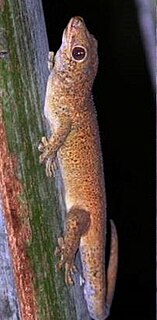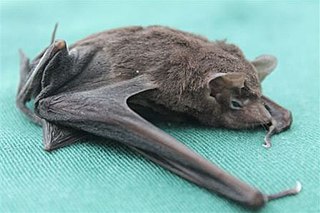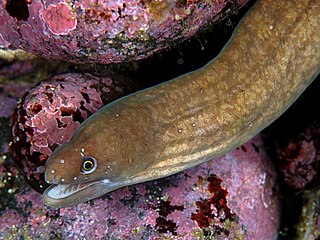
The Seychelles fruit bat or Seychelles flying fox is a megabat found on the granitic islands of Seychelles, and on the Comoros and Mafia Island. It is a significant component of the ecosystems for the islands, dispersing the seeds of many tree species. Although it is hunted for meat on some islands, it remains abundant. It is particularly common on Silhouette Island.

Coleura is a genus of sac-winged bats in the family Emballonuridae.

The Seychelles skink is a species of skink in the family Scincidae. It is endemic to the Seychelles.
The Seychelle Islands treefrog or Seychelles treefrog is a species of frog in the family Hyperoliidae. It is endemic to Seychelles. Its natural habitats are subtropical or tropical moist lowland forest, rivers, swamps, freshwater marshes, intermittent freshwater marshes, plantations, rural gardens, heavily degraded former forest, and irrigated land.

The Seychelles bronze gecko is a species of lizard in the family Gekkonidae endemic to Seychelles.

The Seychelles wolf snake is a species of snake in the family Colubridae. It is monotypic within the genus Lycognathophis. The New Latin name, Lycognathophis, is derived from the Greek words λύκος (lykos) meaning "wolf", γνάθος (gnathos) meaning "jaw", and όφις (ophis) meaning "snake", referring to the snake's dentition.

The Seychelles sheath-tailed bat is a sac-winged bat found in the central granitic islands of the Seychelles. It is an insectivorous bat, feeding primarily in forest clearings at night and roosting in communal roosts by day. Although previously abundant across the island group, it now only occurs on three islands. Its numbers have been declining to such an extent that the International Union for Conservation of Nature has listed it as being critically endangered. Increases in the cultivation of coconut palms in plantations, and the introduction of alien plant species, seem to have reduced the availability of insect food.

Anarchias seychellensis is a moray eel found in coral reefs in the Pacific and Indian Oceans. It was first named by J. L. B. Smith Smith in 1962, and is commonly known as the Seychelles moray or the marbled reef-eel.
Paraphytoseius is a genus of mites in the Phytoseiidae family.
Paraphytoseius hilli is a species of mite in the family Phytoseiidae.
Paraphytoseius horrifer is a species of mite in the family Phytoseiidae.
Paraphytoseius hualienensis is a species of mite in the family Phytoseiidae.
Paraphytoseius hyalinus is a species of mite in the family Phytoseiidae.
Paraphytoseius orientalis is a species of mite in the family Phytoseiidae.
Paraphytoseius santurcensis is a species of mite in the family Phytoseiidae.
Paraphytoseius scleroticus is a species of mite in the family Phytoseiidae.
Stanulus seychellensis, the Seychelle's blenny, is a species of combtooth blenny found in coral reefs in the Pacific and Indian oceans. This species feeds primarily off of plants, including benthic algae and weeds. This species can reach a length of 4 centimetres (1.6 in) TL. This fish is also found in the aquarium trade.
Alucita seychellensis is a species of moth of the family Alucitidae described by Thomas Bainbrigge Fletcher in 1910. It is known from the Seychelles in the Indian Ocean.

The West African mud turtle, also known as the West African side-necked turtle or swamp terrapin, is a species of turtle in the family Pelomedusidae. Pelusios castaneus is a freshwater species and is endemic to West and Central Africa.







